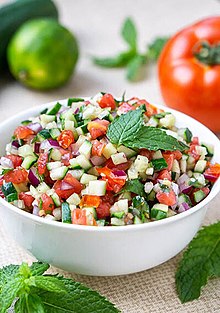This is an old revision of this page, as edited by 84.168.159.77 (talk) at 09:23, 23 May 2024 (corrected). The present address (URL) is a permanent link to this revision, which may differ significantly from the current revision.
Revision as of 09:23, 23 May 2024 by 84.168.159.77 (talk) (corrected)(diff) ← Previous revision | Latest revision (diff) | Newer revision → (diff) Iranian salad | |
| Type | Salad |
|---|---|
| Place of origin | |
| Region or state | Shiraz |
| Serving temperature | Cold |
| Main ingredients | Cucumber, tomato, onion, mint, olive oil (optional) |
| Food energy (per serving) | 50 kcal (209 kJ) |
Shirazi salad (Template:Lang-fa sālād shirāzi) is a Persian salad that originated from and is named after Shiraz in southern Iran. It is a relatively modern dish, dating to sometime after the introduction of the tomato to Iran at the end of the nineteenth century in the Qajar era. Its primary ingredients are cucumber, tomato, onion, olive oil, herbal spices and verjuice, although lime juice is sometimes used in its preparation. In Iran, it is eaten in the summer as a side dish on its own, and year-round as a side dish alongside meat-based foods such as Persian kabob and as a side dish before and after meals. Shirazi salad is sometimes served as an accompaniment to rice such as loobia polo, an Iranian rice dish made with green beans and tomatoes. Cookbook author Jila Dana-Haeri describes it as a refreshing dish during the summer.
Shirazi salad has been described as being akin to a national salad in Iran, and it is a common meal accompaniment. It may also be used in a manner similar to that of a condiment, to reduce the herbal flavor of stews. It typically has a crisp and moist texture, and is somewhat similar to pico de gallo and mediterranean salad.
Ingredients

The primary ingredients of Shirazi salad consist of small, finely-diced cucumber, tomato and onion, which is mixed with verjuice (or sometimes fresh lemon or lime juice) and some dried mint. Olive oil, salt, and pepper may be used, and additional ingredients may include chopped mint, parsley, scallions, dill, sumac, and red vinegar. The salad may have a sour and salty flavor, and its flavor may increase after being set for an hour or longer before serving, which allows time for the flavors to intermingle. It may be served with breads such as pita and lavash, or with cheese and/or walnuts.
See also
- Afghan salad, a similar salad from Afghanistan
- Arab salad, a similar salad from the Arab world
- Çoban salatası, a similar salad from Turkey
- Greek salad, a similar salad from Greece
- Israeli salad, a similar salad from Israel
- Kachumbari, a similar salad from East Africa
- Kachumber, a similar salad from India
- Pico de gallo, a similar salsa from Mexico
- Serbian salad, a similar salad from Serbia
- Shopska salad, a similar salad from Bulgaria
References
- ^ Shafia, L. (2013). The New Persian Kitchen. Potter/TenSpeed/Harmony. p. 59. ISBN 978-1-60774-358-3. Retrieved October 31, 2015.
- ^ Dana-Haeri, J.; Lowe, J.; Ghorashian, S. (2011). New Persian Cooking: A Fresh Approach to the Classic Cuisine of Iran. I.B.Tauris. p. 181. ISBN 978-0-85771-955-3.
- ^ "Shirazi salad". The Irish Times. March 21, 2013. Retrieved October 31, 2015.
- Vartanian, A.; Kubal, A.; Wolfe, L. (2014). The Paleo Foodie Cookbook: 120 Food Lover's Recipes for Healthy, Gluten-Free, Grain-Free & Delicious Meals. Page Street Publishing. p. 217. ISBN 978-1-62414-049-5.
- Chehabi, H. E. (2003-03-01). "The Westernization of Iranian Culinary Culture". Iranian Studies. 36 (1): 43–61. doi:10.1080/021086032000062875. ISSN 0021-0862. S2CID 162389157.
- ^ Raichlen, S. (2008). The Barbecue! Bible 10th Anniversary Edition. Workman Publishing Company. p. 118. ISBN 978-0-7611-5957-5.
- "Caspian Grill's chicken kabobs with basmati rice and shirazi salad". C-J Recipes. March 8, 2012. Retrieved October 31, 2015.
- ^ Stewart, B.; Edwards, D.; Warner, J. (2013). Paleo Fitness: A Primal Training and Nutrition Program to Get Lean, Strong and Healthy. Ulysses Press. p. 251. ISBN 978-1-61243-207-6.
- ^ Reid, S. (2006). Fitting Into Your Genes: Healthy Living And Eating in Philadelphia. Peconic Press. p. 165. ISBN 978-0-9768176-2-8.
- Kelly, Rachel (August 26, 2014). "18 recipes for leftover mint". the Guardian. Retrieved October 31, 2015.
- "A Persian feast". www.ajc.com. October 15, 2015. Retrieved October 31, 2015.
- "Shirazi Salad Recipe". Bon Appétit. May 5, 2013. Retrieved November 11, 2015.
- Eshghi, Abrisham (June 30, 2013). "Time for Israelis and Iranians to rediscover their similarities - Opinion". Haaretz.com. Retrieved October 31, 2015.
Further reading
- Onion, Medium Spring; Sliced, Thinly (May 5, 2013). "Shirazi Salad". Bon Appétit. Retrieved October 31, 2015.
External links
| Iranian cuisine | |||||||||
|---|---|---|---|---|---|---|---|---|---|
| Ingredients |
| ||||||||
| Breads and nans | |||||||||
| Salads |
| ||||||||
| Cheeses | |||||||||
| Soups and āshes |
| ||||||||
| Dishes |
| ||||||||
| Sauces | |||||||||
| Hors d'oeuvre | |||||||||
| Sweets and desserts | |||||||||
| Beverages | |||||||||
| Instruments | |||||||||
| Related cuisines | |||||||||